Indulgence, tradition, and craftsmanship converge in the world of gastronomy, and among the finest examples of this harmonious trinity is Stilton Cheese. From the verdant hills of rural England to the elegant platters of high-end dining establishments, Stilton Cheese stands as an embodiment of culinary excellence that transcends time. This article invites you on a captivating journey into the captivating universe of Stilton Cheese, where centuries-old craftsmanship, a unique terroir, and an unmistakable flavor profile coalesce to create a sensory experience unlike any other. Prepare to be enticed by the rich history, the meticulous artistry, and the unparalleled taste of Stilton Cheese, as we delve into the story of this ageless delicacy that has tantalized palates for generations.
¿What is Stilton Cheese?
Stilton Cheese is a world-renowned blue cheese that originates from England. It is characterized by its crumbly yet creamy texture, distinctive blue veining, and a complex, robust flavor profile. This cheese holds a protected designation of origin status, meaning that only cheeses produced in specific regions and according to traditional methods can be labeled as “Stilton.”
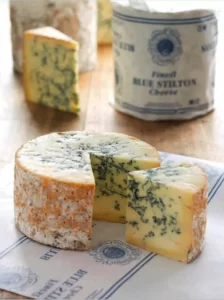
Traditionally made from cow’s milk, Stilton Cheese undergoes a meticulous production process. The curds are hand-ladled into cylindrical molds, allowing the whey to drain naturally. After a period of aging, the cheese is pierced with stainless steel needles to encourage the growth of the blue mold Penicillium roqueforti, which gives Stilton its signature blue veins and imparts its characteristic tangy taste.
The result is a cheese that strikes a perfect balance between the crumbly, creamy texture and the bold, earthy flavors. Its flavor profile is often described as rich, slightly sweet, and tangy, with underlying notes of mushroom and grass. Stilton Cheese is not just a culinary delight; it’s a symbol of centuries-old craftsmanship, a connection to the English countryside, and a cornerstone of gourmet cuisine worldwide.
Intriguingly versatile, Stilton can be enjoyed on its own, accompanied by fruits and nuts, or as a star ingredient in various dishes, lending its distinctive taste to salads, sauces, and even desserts. Its ability to elevate both simple and elaborate dishes makes it a favorite among chefs and cheese enthusiasts alike.
From its storied history dating back to the early 18th century to its esteemed place on cheese boards and in culinary creations today, Stilton Cheese remains a testament to the artistry and dedication of cheesemakers who have upheld its legacy for generations.
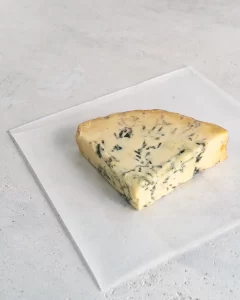
Characteristics
Stilton Cheese boasts a range of distinct characteristics that contribute to its unique identity and enduring popularity:
- Flavor Profile: Stilton’s flavor is a harmonious blend of rich, tangy, and savory notes. Its taste evolves as it ages, with younger cheeses showcasing a milder, creamier profile and older ones displaying a more intense and robust flavor. The cheese’s inherent tanginess is balanced by a subtle sweetness, creating a complex taste experience.
- Texture: This cheese features a crumbly yet creamy texture that effortlessly melts in the mouth. Its crumbliness is a result of the curd-handling process during production, while its creaminess comes from the high butterfat content in cow’s milk.
- Blue Veining: Stilton is renowned for its distinctive blue veins, which are formed by the introduction of Penicillium roqueforti mold during production. These veins add an eye-catching aesthetic and contribute to the cheese’s bold flavor.
- Aroma: Stilton Cheese exudes an inviting aroma characterized by its earthy, mushroom-like undertones. The aroma intensifies as the cheese matures, giving it an appealing olfactory allure.
- Color: The cheese’s interior is pale ivory with intricate blue veining. The rind, which is not meant to be eaten, can range in color from beige to yellow.
- Aging Process: Stilton is typically aged for a minimum of three months, but it can be aged for longer periods, with some varieties aged for over a year. This extended aging allows the flavors and textures to develop fully.
- Protected Designation of Origin (PDO): Authentic Stilton Cheese must adhere to strict production standards and geographical requirements to bear the name. It can only be produced in three English counties: Derbyshire, Nottinghamshire, and Leicestershire.
- Cylindrical Shape: Stilton Cheese is traditionally shaped into cylindrical forms, which are hand-ladled with curds during production to ensure a consistent texture and taste throughout.
- Versatility: While Stilton is delightful on its own, it is also a versatile ingredient in culinary creations. Its robust flavor pairs well with fruits, nuts, honey, and even desserts, making it a favorite in both savory and sweet dishes (or grilled).
- Cultural and Culinary Significance: Stilton Cheese is a beloved and iconic part of British culinary heritage. It holds a special place in celebrations, holiday feasts, and fine dining experiences, embodying centuries of tradition and craftsmanship.
From its striking appearance to its captivating taste and storied history, Stilton Cheese is a gastronomic masterpiece that continues to captivate palates and evoke a sense of culinary indulgence.
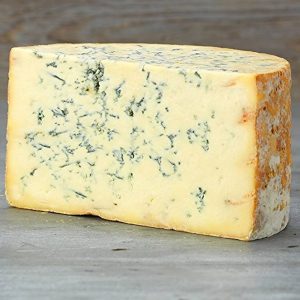
Origin
Stilton Cheese’s origin is rooted in the picturesque villages of rural England, where its unique production methods and distinct flavor profile were developed over centuries. The exact origin story is often shrouded in legend and anecdote, but there are a few key historical points that shed light on its beginnings:
- Early 18th Century: The creation of Stilton Cheese is generally attributed to the early 18th century. The Bell Inn, located in the village of Stilton in Cambridgeshire, England, is often mentioned as a significant location in the cheese’s history. It is said that travelers passing through the inn encountered the cheese and were captivated by its exceptional taste. The inn’s reputation as a stopover for travelers helped spread the popularity of Stilton Cheese.
- Traditional Recipe: The cheese’s original recipe and production methods were likely influenced by the burgeoning dairy industry of the region. Local farmers and cheesemakers would have used traditional techniques to create the cheese, capitalizing on the abundant cow’s milk available in the area.
- Evolution of Craftsmanship: Over time, the production techniques for Stilton Cheese evolved, incorporating knowledge gained from neighboring dairy regions. Cheesemakers refined the process to create a cheese with a crumbly texture, blue veining, and a distinctive flavor profile.
- Geographical Indication: The unique qualities of Stilton Cheese led to its recognition and popularity beyond the village of Stilton. The cheese’s reputation grew, and it eventually earned the status of a coveted delicacy enjoyed by people from various walks of life.
- Official Recognition: The first documented reference to Stilton Cheese dates back to the early 18th century. By the 19th century, it was well-established and gaining recognition for its quality and taste. In 1936, Stilton Cheese became one of the first British foods to receive legal protection through a certification trademark.
- Geographical Limitations: While Stilton Cheese’s name comes from the village of Stilton, it’s interesting to note that it’s not actually produced there. The production of Stilton Cheese is now confined to the three counties of Derbyshire, Nottinghamshire, and Leicestershire, which are collectively known as the “Stilton Belt.”
- Protected Designation of Origin (PDO): The PDO status, granted in 1996, ensures that only cheeses produced in these designated counties and adhering to specific traditional methods can be labeled as “Stilton Cheese.” This designation safeguards the cheese’s authenticity and heritage.
Today, Stilton Cheese remains a symbol of British culinary excellence and craftsmanship. Its origins are entwined with a rich history of innovation, tradition, and appreciation for the fine art of cheesemaking.
¿HOW IS MADE?
Stilton Cheese is crafted through a meticulous process that combines traditional methods with modern techniques to achieve its distinctive flavor, texture, and appearance. Here is an overview of how Stilton Cheese is made:
- Milk Sourcing: High-quality, pasteurized cow’s milk is the primary ingredient in Stilton Cheese production. The milk is sourced from dairy farms within the designated Stilton-producing regions: Derbyshire, Nottinghamshire, and Leicestershire.
- Curdling: The process begins by adding starter cultures and rennet to the milk. Starter cultures consist of bacteria that acidify the milk and contribute to the cheese’s flavor development. Rennet helps coagulate the milk, forming curds and whey.
- Cutting and Draining: Once the curds have formed, they are cut into small pieces to facilitate whey drainage. The curds are then gently stirred and heated to encourage further separation of the curds from the whey.
- Molding: The curds are ladled into cylindrical molds using traditional methods. The molds help shape the cheese and further release whey. This hand-ladling process contributes to the crumbly texture characteristic of Stilton.
- Pressing: After draining in the molds, the curds are gently pressed to expel more whey and compact the cheese (like this goat cheese).
- Salting: The cheese is salted to enhance its flavor and aid in moisture control. Salt is either applied directly to the surface of the cheese or mixed into the curds before molding.
- Piercing: One of the most distinctive steps in Stilton Cheese production is the piercing process. Stainless steel needles are inserted into the cheese to create channels for air to flow. This encourages the growth of blue mold (Penicillium roqueforti) within the cheese, resulting in the characteristic blue veining.
- Aging: Stilton Cheese is aged in controlled environments for a minimum of three months, although some varieties can be aged for much longer. During aging, the flavors and textures continue to develop, and the blue veins spread throughout the cheese.
- Maturation and Monitoring: Cheesemakers carefully monitor the aging process, turning and caring for the cheeses to ensure uniform development of flavor and texture.
- Packaging and Distribution: Once the desired aging period is complete, the cheeses are packaged for distribution. They are wrapped in foil or wax paper to preserve freshness and prevent excessive drying.
Throughout this process, the craftsmanship of experienced cheesemakers plays a crucial role in achieving the desired characteristics of Stilton Cheese. The combination of curd-handling techniques, controlled aging conditions, and the introduction of blue mold all contribute to the cheese’s crumbly texture, tangy flavor, and striking appearance. The result is a cheese that stands as a testament to the artistry and dedication of those who continue to uphold the traditions of Stilton production.

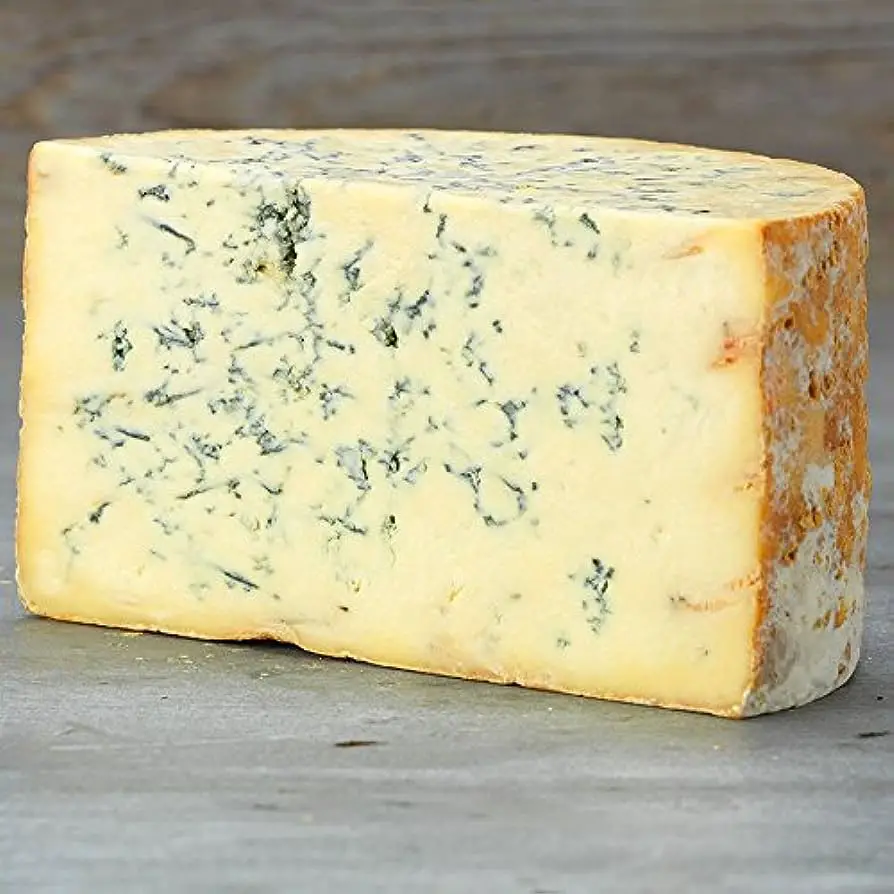

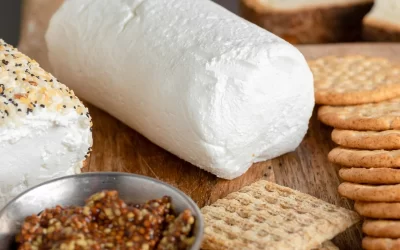
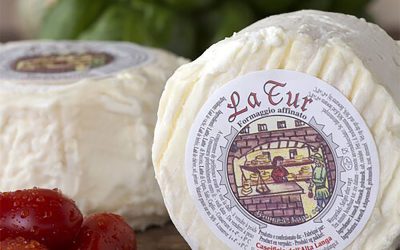
0 Comments